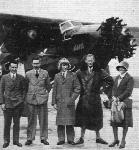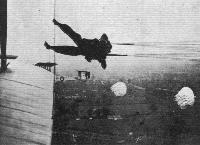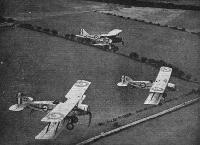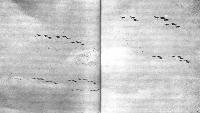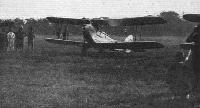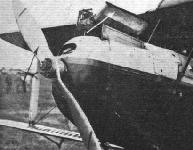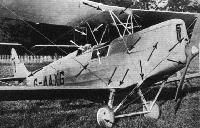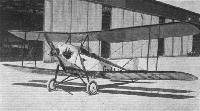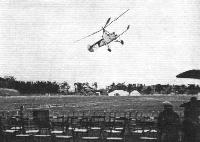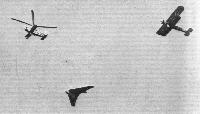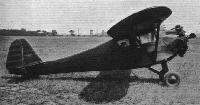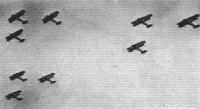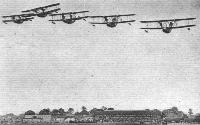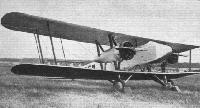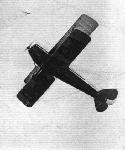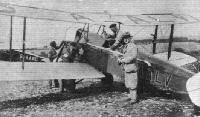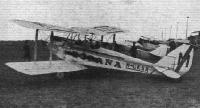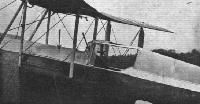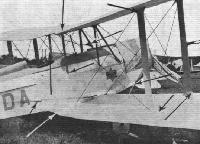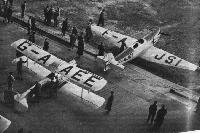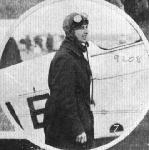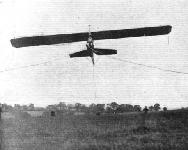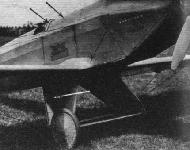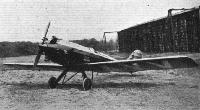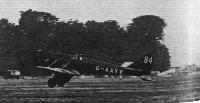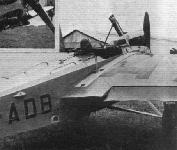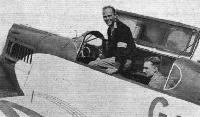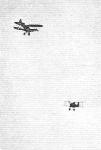Фотографии
-
Регистрационный номер: VH-USU "Southern Cross" after overhaul at the Fokker factory in 1930. The new-type registration was applied for the first time and the Fokker trade mark and designation F-VII/3M on the fin.
Самолёты на фотографии: Fokker F.VII / C-2 / F.XIV - Нидерланды - 1924
-
THE CREW OF THE "SOUTHERN CROSS": From left to right - Mr. J. W. Stannage (Wireless); Capt. P. Saul (Navigator); Sq.-Ldr. Kingsford-Smith; Mr. Van Dyk (2nd Pilot). Miss Mary Powell, Kingsford-Smith's fiancee, is on the extreme right.
Самолёты на фотографии: Fokker F.VII / C-2 / F.XIV - Нидерланды - 1924
-
The Pilots' Cockpit and Instruments.
Самолёты на фотографии: Fokker F.VII / C-2 / F.XIV - Нидерланды - 1924
-
The Wireless Equipment in the Navigator's cabin.
Самолёты на фотографии: Fokker F.VII / C-2 / F.XIV - Нидерланды - 1924
-
A general view of the Navigator's and Wireless Operator's cabin.
Самолёты на фотографии: Fokker F.VII / C-2 / F.XIV - Нидерланды - 1924
-
Another section of the Navigator's cabin, showing the Longines Chronometer (extreme right).
Самолёты на фотографии: Fokker F.VII / C-2 / F.XIV - Нидерланды - 1924
-
The fuel distributing system in the pilots' cockpit.
Самолёты на фотографии: Fokker F.VII / C-2 / F.XIV - Нидерланды - 1924
-
Parachute Section, Home Aircraft Depot: Six parachutists leaving the three Vimys.
Самолёты на фотографии: Vickers Vimy / FB.27 - Великобритания - 1917
-
Tense Moments Parachutists being pulled off. The machines are Vickers Vimys.
Самолёты на фотографии: Vickers Vimy / FB.27 - Великобритания - 1917
-
A Formation of Bristol Fighters. Note the Cambridge arms on the fins.
Самолёты на фотографии: Bristol F.2A/F.2B Fighter - Великобритания - 1916
-
Squadron Aerobatics: The Machines of No. 43 (Fighter) Squadron in formation. Note that the machines of each flight are tied together.
Самолёты на фотографии: Armstrong Whitworth Siskin - Великобритания - 1921
-
54 Machines flying past: Three Fighter Squadrons on Siskins, one Bomber Squadron on Foxes, and two Bomber Squadrons on III F's.
Самолёты на фотографии: Armstrong Whitworth Siskin - Великобритания - 1921Fairey Fairey IIIF - Великобритания - 1926Fairey Fox - Великобритания - 1925
-
Strafing the Kite Balloon: A Siskin attacking.
Самолёты на фотографии: Armstrong Whitworth Siskin - Великобритания - 1921
-
THE WESTLAND "WESSEX ": A new version of the Westland IV Limousine, a six-seater commercial cabin monoplane fitted with three Armstrong-Siddeley "Genet-Majors." Four of these machines have been ordered by "Sabena," the premier air line operating in Belgium and the Belgian Congo. On July 2, M. Cocquyt, of "Sabena," took delivery of the first machine, and before flying it to Belgium he made a series of test flights, with which he expressed himself extremely satisfied. Incidentally, the marking "P-" is the "trade" number allotted to the Westland Aircraft Works for aircraft which have not yet received their full registration letters.
Самолёты на фотографии: Westland Wessex / Westland IV - Великобритания - 1929
-
The Limit Man: Mr. Sutcliffe starts the ball rolling at 7 a.m.
Самолёты на фотографии: De Havilland Moth / D.H.60 - Великобритания - 1925
-
A fast Second: Mr. Butler's "Gipsy Moth" being led in.
Самолёты на фотографии: De Havilland Moth / D.H.60 - Великобритания - 1925
-
Lieut. Richardson's "Moth" (Cirrus III), No. 66, had a Fairey metal propeller, and a complete metal fairing around the rather long exhaust stubs (102-36 m.p.h.).
Самолёты на фотографии: De Havilland Moth / D.H.60 - Великобритания - 1925
-
Mr. Alan Butler leaving his machine after flying a very good race.
Самолёты на фотографии: De Havilland Moth / D.H.60 - Великобритания - 1925
-
Регистрационный номер: G-AAXG [2] Mr. Butler's "Moth" (Gipsy II), No. 76, was "cleaned up" with extreme care. The thin centresection was mounted on Vee struts and braced by vertical wires. The small undercarriage was carefully faired, and all strut and wire ends faired into the surfaces. The engine cowling completely covered the engine, with very small front openings. The cowling line continued aft over the passenger's cockpit, and merged from pilot's cockpit very cleanly into the tail. Mr. Butler averaged 129.7 m.p.h. around the course, thus gaining award for greatest speed.
Самолёты на фотографии: De Havilland Moth / D.H.60 - Великобритания - 1925
-
Регистрационный номер: G-AAUO A TWO-SEATER, side-by-side biplane of recent production and of wood construction. Designed for very low landing speed and ease of handling by pilots of only medium skill. The engine is an A.B.C. "Hornet."
Самолёты на фотографии: Robinson Redwing - США - 1930
-
Регистрационный номер: J9130 THE LATEST HANDLEY-PAGE NIGHT BOMBER: The engines are Rolls-Royce "F" type. Note the placing of the fuselage under the top plane.
Самолёты на фотографии: Handley Page Heyford / H.P.38 / H.P.50 - Великобритания - 1930
-
Prince George is shown the new night bomber with its streamlined wheels.
Самолёты на фотографии: Handley Page Heyford / H.P.38 / H.P.50 - Великобритания - 1930
-
Captain Rawson "crazy-flying" on the Cierva "Autogiro."
Самолёты на фотографии: Cierva/Avro C.19 - Великобритания - 1929
-
Регистрационный номер: G-AACN [2], G-AAUA The "Freak Formation": The Cierva Autogiro in the lead, with the Handley Page Gugnunc on the left and the Hill Pterodactyl on the right.
Самолёты на фотографии: Cierva/Avro C.19 - Великобритания - 1929Handley Page Gugnunc / H.P.39 - Великобритания - 1929Westland-Hill Pterodactyl - Великобритания - 1925
-
Mr. Napier's "Widgeon" (Gipsy I), No. 18, had passenger's cockpit covered in, a fairing, to the bottom of fuselage to cover controls, new fairing over compression legs, and neat engine cowling. (98.67 m.p.h.)
Самолёты на фотографии: Westland Widgeon - Великобритания - 1924
-
Регистрационный номер: G-EBRM HARD LINES! Mr. R. Cazalet, who has flown his Widgeon (Hermes) in many races at air meetings, has always had an almost insuperable handicap. At Bristol he finished third only to find that he had been disqualified for slightly cutting the Filton corner.
Самолёты на фотографии: Westland Widgeon - Великобритания - 1924
-
Регистрационный номер: G-AACN [2] The "Gugnunc" taxies hard out of the shed and promptly takes off.
Самолёты на фотографии: Handley Page Gugnunc / H.P.39 - Великобритания - 1929
-
The Pterodactyl (original model).
Самолёты на фотографии: Westland-Hill Pterodactyl - Великобритания - 1925
-
THE LATEST "PTERODACTYL": This is the machine which it had been intended to show at the R.A.F. Display. It differs from that shown in the official Display programme in that the wheels are in tandem. The engine is an Armstrong Siddeley "Genet."
Самолёты на фотографии: Westland-Hill Pterodactyl - Великобритания - 1925
-
THE FAIREY "FIREFLY": These three views give a very good idea of the clean lines of this interceptor fighter. The engine is a Rolls-Royce supercharged "F" type.
Самолёты на фотографии: Fairey Firefly - Великобритания - 1925
-
Самолёты на фотографии: Fairey Firefly - Великобритания - 1925
-
"ON HIS TAIL": A Fairey "Firefly," piloted by Flight-Lieutenant Staniland, in hot pursuit of another Fairey machine, piloted by Flying Officer McMullin, the tail of which can be seen in the foreground. Note that the two machines are circling and banking.
Самолёты на фотографии: Fairey Firefly - Великобритания - 1925
-
EVOLUTION BY THREE DAY BOMBER SQUADRONS: Fairey Foxes in the lead, two Fairey III squadrons on the wings. The Foxes kept the better formation.
Самолёты на фотографии: Fairey Fairey IIIF - Великобритания - 1926Fairey Fox - Великобритания - 1925
-
ROYAL TRANSPORT: The Prince of Wales's Wapiti and Escort at Ipswich
Самолёты на фотографии: Westland Wapiti - Великобритания - 1927
-
Prince of Wales arriving at Ipswich in the Wapiti which was built for his personal use.
Самолёты на фотографии: Westland Wapiti - Великобритания - 1927
-
"The Terriers": No. 600 (City of London) Bomber Squadron of the Auxiliary Air Force keeps wonderful formation.
Самолёты на фотографии: Westland Wapiti - Великобритания - 1927
-
Самолёты на фотографии: Saunders-Roe Cloud / A.19 - Великобритания - 1930
-
Saro "Flying Cloud" (6-8 seater) 2 Wright "Whirlwind" Engines
Самолёты на фотографии: Saunders-Roe Cloud / A.19 - Великобритания - 1930
-
The Junkers W.33 monoplane (Junkers engine) owned by Walcot Air Line, Ltd.
Самолёты на фотографии: Junkers W 33 / W 34 / Ju.46 - Германия - 1926
-
Регистрационный номер: G-AAYW [2] MEMBERS OF THE AVRO FAMILY: Beginning with the machine in the foreground, the types lined up are: The "Avian Monoplane," the "Avian" biplane, the "Avro Trainer," the Avro Five and the Avro Six.
Самолёты на фотографии: Avro Avian / Type 594/616 - Великобритания - 1926Avro Avian Monoplane / Type 625 - Великобритания - 1930Avro Five / Type 619 / Six / Type 624 - Великобритания - 1929Avro Tutor/Sea Tutor/Prefect / Type 621/646/626 - Великобритания - 1929
-
ONE OE THE CAUDRON BIPLANES BEING WEIGHED: This particular machine is fitted with a Renault engine.
Самолёты на фотографии: Caudron C.230 / C.270 / Luciole - Франция - 1930
-
Регистрационный номер: G-AAVL, G-AAZH FOREIGN COMPETITORS: The Breda and Klemm at the flying meeting.
Самолёты на фотографии: Breda Ba.15 - Италия - 1928Klemm L.25 - L.28 Swallow - Германия - 1927
-
SEEN AT HESTON: GERMAN MONOPLANE TAKING PART IN THE COMPETITION: 2, a Klemm with Salmson engine with Townend fitted Ring.
Самолёты на фотографии: Klemm L.25 - L.28 Swallow - Германия - 1927
-
SEEN AT HESTON: GERMAN MONOPLANE TAKING PART IN THE COMPETITION: 3, An "unfaked" Klemm with Siemens engine.
Самолёты на фотографии: Klemm L.25 - L.28 Swallow - Германия - 1927
-
THE KLEMM: Mr.Rogers standing before a Cirrus-Klemm.
Самолёты на фотографии: Klemm L.25 - L.28 Swallow - Германия - 1927
-
STYLE IN COUPE TOPS: One of the Klemms. The cabin roof of the Klemm telescopes, the panels being celluloid covered.
Самолёты на фотографии: Klemm L.25 - L.28 Swallow - Германия - 1927
-
A SWISS COMPETITOR: This Klemm monoplane with inverted Argus engine has been entered and is being piloted by Herr Charles Kolp. Note that it has a coupe roof built over cockpits.
Самолёты на фотографии: Klemm L.25 - L.28 Swallow - Германия - 1927
-
SOME "RUNDFLUG NOSES": 3, a Klemm with inverted Argus engine. The cockpit roof telescopes.
Самолёты на фотографии: Klemm L.25 - L.28 Swallow - Германия - 1927
-
FOR THE INTERNATIONAL TOURING COMPETITION: The American "Monocoupe" Special with Warner "Scarab" engine, has been entered by Mr. Trench, and is to be piloted by Mr. Carberry. The machine has side-by-side seating. The wheels are Goodrich and brakes are fitted.
Самолёты на фотографии: Monocoupe 90 / 110 / 145 - США - 1930
-
THE BRITISH REPRESENTATIVES: So far all the British Competitors have been doing well in the Circuit of Europe. Here they are shown during their stay at Heston: 3, Mr. Carberry in the Monospecial.
Самолёты на фотографии: Monocoupe 90 / 110 / 145 - США - 1930
-
WAITING FOR THE FLAG: Two "Avro Avian Sports" and a "Puss Moth" on the Starting Line.
Самолёты на фотографии: Avro Avian / Type 594/616 - Великобритания - 1926De Havilland Puss Moth / D.H.80 - Великобритания - 1929
-
Регистрационный номер: G-AAVT [3], G-ABBH AT MRS. BALDWIN'S NATIONAL BIRTHDAY TRUST FUND MEETING AT HANWORTH: The photograph shows some of the faster machines lined up for the start.
Самолёты на фотографии: De Havilland Puss Moth / D.H.80 - Великобритания - 1929Hendy Hendy 302 - Великобритания - 1929
-
Регистрационный номер: G-AAXL, G-AAXO Neck and Neck: Mrs. Butler and Capt. de Havilland getting away in their "Puss Moths."
Самолёты на фотографии: De Havilland Puss Moth / D.H.80 - Великобритания - 1929
-
PIRATES BOLD: The Pirates try to take off in the stolen aircraft, but bombs are dropped by British "Horsleys'' (on photo) with good effect.
Самолёты на фотографии: Hawker Horsley / Dantorp - Великобритания - 1925
-
Трехместный легкий самолет L.100 в серийное производство не передавался.
FOR THE CIRCUIT OF EUROPE: One of new German types. The Albatros L.100, an all-metal low-wing monoplane three-seater with Argus engine.Самолёты на фотографии: Albatros L.100 - Германия - 1930
-
FOR THE CIRCUIT OF EUROPE: One of new German types. The Albatros L.101, a parasol monoplane two-seater, also with Argus engine, and of metal construction
Самолёты на фотографии: Albatros L.101 - Германия - 1930
-
Регистрационный номер: D-1895 SEEN AT HESTON: GERMAN MONOPLANE TAKING PART IN THE COMPETITION: 4, The Albatros L.101 parasol monoplane with inverted Argus engine.
Самолёты на фотографии: Albatros L.101 - Германия - 1930
-
Регистрационный номер: D-1876 THE ARADO MONOPLANE: A German Machine, the first to be fitted with the new inverted Argus engine. Note the large streamline casings around the shock absorbers.
Самолёты на фотографии: Arado L.II - Германия - 1929
-
THE WINNER: Miss Winifred Brown, tired but happy, gives the photographers a chance at Hanworth at the end of the race.
Самолёты на фотографии: Avro Avian / Type 594/616 - Великобритания - 1926
-
Регистрационный номер: G-EBVZ THE END OF A PERFECT DAY: Miss Brown's "Avian" is seen at the moment of crossing the finishing line.
Самолёты на фотографии: Avro Avian / Type 594/616 - Великобритания - 1926
-
A HERMES AVIAN: Henlys, Ltd., of Piccadilly, have bought this Avian for their aviation representative.
Самолёты на фотографии: Avro Avian / Type 594/616 - Великобритания - 1926
-
THE HONG KONG CLUB: The two machines of the Club are shown against a background which makes forced landings undesirable! For this reason, the land undercarriage will also be changed for floats. Both machines are Avians ("Hermes") and a lot of good work has been done on them.
Самолёты на фотографии: Avro Avian / Type 594/616 - Великобритания - 1926
-
Регистрационный номер: G-AAHJ [2] THE BRITISH REPRESENTATIVES: So far all the British Competitors have been doing well in the Circuit of Europe. Here they are shown during their stay at Heston: 4, Mr. Thorn slows down (Hermes-Avian).
Самолёты на фотографии: Avro Avian / Type 594/616 - Великобритания - 1926
-
Регистрационный номер: G-AAHJ [2] Mr. Thorn's "Avian" (Hermes), No. 41, had very short exhaust stubs, metal fairings to strut ends, wing roots faired into fuselage, passenger's cockpit covered, and a long narrow windscreen for the pilot (117-95 m.p.h.)
Самолёты на фотографии: Avro Avian / Type 594/616 - Великобритания - 1926
-
Регистрационный номер: G-AAFX G-AAFX - один из DH.75А с двигателем Armstrong Siddeley Lynx VIA мощностью 240л.с. Самолет специально для фотографа выполняет проход на малой высоте. Первый полет G-AAFX совершил в 1929 году, а в следующем году его продали в Австралию.
A HIGH-WING braced monoplane of mixed construction. Suitable for "Feeder Line" and air taxi work, or for the private owner. Seats pilot and 4-5 passengers. The engine is a "Lynx." Entered by Prince George.Самолёты на фотографии: De Havilland Hawk Moth / D.H.75 - Великобритания - 1928
-
Регистрационный номер: G-AAUZ PRINCE GEORGE'S ENTRY STARTING: The De Havilland "Hawk Moth," piloted by Flight-Lieutenant Fielden, leaving Hanworth.
Самолёты на фотографии: De Havilland Hawk Moth / D.H.75 - Великобритания - 1928
-
The Segrave "Meteor" (2 Gipsy III), No. 10, was flown in its standard form. Note neat engine cowling. Defective fuel feed compelled this interesting machine to return to Hanworth.
Самолёты на фотографии: Blackburn Segrave Meteor / B-1 - Великобритания - 1930
-
DESIGNED by the late Sir Henry Segrave, and built by Saunders-Roe, this machine, of all-wood construction, is a twin-engined monoplane with high performance. First appearance in public. The engines are inverted "Gipsy III," faired into the wing.
Самолёты на фотографии: Blackburn Segrave Meteor / B-1 - Великобритания - 1930
-
The Blackburn Lincock
Самолёты на фотографии: Blackburn Lincock / F.2 - Великобритания - 1928
-
An early-morning duet: The two "Bluebirds" entered by Lord Trenchard and Sir Philip Sassoon get the signal from Col. Lindsay Lloyd.
Самолёты на фотографии: Blackburn Bluebird / L.1 - Великобритания - 1924
-
Регистрационный номер: G-AATN THIRD: Flight-Lieutenant Waghorn studying his map and, on the right, walking away from his "Bluebird."
Самолёты на фотографии: Blackburn Bluebird / L.1 - Великобритания - 1924
-
Регистрационный номер: G-AACC On Tommy Rose's "Bluebird" (Hermes), No. 21, the exhaust stubs were faired in, the passenger's side of the cockpit was covered over, the pilot's head streamlined, and the lower wings faired into the fuselage (109-82 m.p.h.).
Самолёты на фотографии: Blackburn Bluebird / L.1 - Великобритания - 1924
-
Sqdn.-Ldr. Woodhouse's "Bluebird" (Gipsy II) No. 93, had a pointed nose and small windscreens. Speed around course 99.59 m.p.h.
Самолёты на фотографии: Blackburn Bluebird / L.1 - Великобритания - 1924
-
The Bleriot-Spad advertising the joys of its native country over Hanworth
Самолёты на фотографии: Bleriot-SPAD S.91 - Франция - 1927
-
Links in the Chain: Three Martlesham pilots giving an exhibition of aerobatics with smoke.
Самолёты на фотографии: Gloster Grebe - Великобритания - 1923
-
Another evolution by the same pilots mounted on Grebes.
Самолёты на фотографии: Gloster Grebe - Великобритания - 1923
-
ITALIAN INVERSION: Major de Bernardi by his Caproni (Hermes) which has been specially built for inverted flying demonstrations and was used by him at the recent Rome meeting.
Самолёты на фотографии: Caproni Ca.100 Caproncino - Италия - 1929
-
Регистрационный номер: G-AAZF SIMILAR to the standard "Swift," except for the engine, which is a Pobjoy radial, geared. With this engine the "Swift" has a performance resembling that of a single-seater fighter, the climb being more than 1,000 ft./min. First public appearance.
Самолёты на фотографии: Comper Swift / CLA.7 - Великобритания - 1930
-
Bombing an Encampment: A Flycatcher dropping its eggs.
Самолёты на фотографии: Fairey Flycatcher - Великобритания - 1922
-
Strafing an Encampment: The Flycatcher zooms after dropping its bombs.
Самолёты на фотографии: Fairey Flycatcher - Великобритания - 1922
-
The new Desoutter II. Our view shows the large doors on each side.
Самолёты на фотографии: Koolhoven FK-41 - Нидерланды - 1928
-
Регистрационный номер: G-AAZI THIS is a recent development of the Mark I machine, and among the changes may be noted the fitting of an inverted engine (Gipsy III), which has improved the view.
Самолёты на фотографии: Koolhoven FK-41 - Нидерланды - 1928
-
Регистрационный номер: J9771 The D.H.77 Interceptor, J9771, on the 1930 Hendon Pageant, powered by a Napier 'H' engine.
Самолёты на фотографии: De Havilland D.H.77 - Великобритания - 1929
-
AT MRS. BALDWIN'S NATIONAL BIRTHDAY TRUST FUND MEETING AT HANWORTH: Sqd.-Ldr. Guest is seen finishing on his "Tomtit."
Самолёты на фотографии: Hawker Tomtit - Великобритания - 1928
-
Регистрационный номер: G-ABAX THE TWO "TOMTITS": The Prince of Wales' machine in the lead, closely followed by Captain Guest's entry.
Самолёты на фотографии: Hawker Tomtit - Великобритания - 1928
-
Регистрационный номер: J9777 AN all-metal training machine (two seater) with Armstrong-Siddeley "Mongoose" engine. In the King's Cup Race, one ol these machines (No. 33) has been entered by the Prince of Wales.
Самолёты на фотографии: Hawker Tomtit - Великобритания - 1928
-
Регистрационный номер: G-AAWZ A "Spartan Arrow": Mr. Andrews waits for Col. Lindsay Lloyd to drop the flag.
Самолёты на фотографии: Spartan Arrow - Великобритания - 1930
-
THE most recent version of the Spartan the "Spartan Arrow" differs in that it has a Clark Y wing section, which reduces some of the interchangeability features slightly, but from which the machine may benefit otherwise. The "Arrow" is to be regarded as the sports type of Spartan. Fitted with Gipsy and Hermes engines.
Самолёты на фотографии: Spartan Arrow - Великобритания - 1930
-
THE BRITISH REPRESENTATIVES: So far all the British Competitors have been doing well in the Circuit of Europe. Here they are shown during their stay at Heston: 5, The Spartan Arrow.
Самолёты на фотографии: Spartan Arrow - Великобритания - 1930
-
Регистрационный номер: D-1863 JUNKERS "JUNIOR": This machine, photographed at the moment of starting from Berlin, is fitted with a Siemens engine. Others of the same type have the Armstrong-Siddeley "Genet."
Самолёты на фотографии: Junkers A 50 Junior - Германия - 1929
-
Регистрационный номер: D-1864 SEEN AT HESTON: GERMAN MONOPLANE TAKING PART IN THE COMPETITION: 1, a Junkers "Junior" refuelling.
Самолёты на фотографии: Junkers A 50 Junior - Германия - 1929
-
The Junkers Junior as a seaplane.
Самолёты на фотографии: Junkers A 50 Junior - Германия - 1929
-
LOW-WING MONOPLANE: A BFW with BMW X radial engine.
Самолёты на фотографии: Messerschmitt BFW M.23 / M.27 - Германия - 1928
-
Регистрационный номер: D-1890 ONE OF THE BFW MONOPLANES: This particular machine is fitted with a Siemens engine, although according to the original list its racing number corresponds to an Argus.
Самолёты на фотографии: Messerschmitt BFW M.23 / M.27 - Германия - 1928
-
STYLE IN COUPE TOPS: One of the BFW Machines
Самолёты на фотографии: Messerschmitt BFW M.23 / M.27 - Германия - 1928
-
SOME "RUNDFLUG NOSES": 1, a BFW M.23 with Siemens-Halske engine. Note Coupe Top.
Самолёты на фотографии: Messerschmitt BFW M.23 / M.27 - Германия - 1928
-
"VEDETTE" AMPHIBIANS AT OTTAWA: A group of "Vedettes" built by Canadian Vickers, Ltd., of Montreal, equipped with Armstrong-Siddeley "Lynx" engines, assembled at Ottawa preparatory to commencing operations in the Northern parts of Canada.
Самолёты на фотографии: Canadian Vickers Vedette - Канада - 1924
-
The Coastal Area: Five Supermarine Southamptons from Calshot visit Hendon.
Самолёты на фотографии: Supermarine Southampton / Solent - Великобритания - 1925
-
BRITISH INFLUENCE: This Polish biplane, flown by B. Orlinski, has a strong resemblance to British light 'planes, and is moreover, fitted with a De Havilland Gipsy engine.
Самолёты на фотографии: PZL PZL.5 - Польша - 1930
-
Регистрационный номер: SP-ADL, SP-ADM SOME OF POLAND'S REPRESENTATIVES ON THE STARTING LINE: The first three machines are of the RWD 4 type, and are fitted with "Hermes" engines.
Самолёты на фотографии: RWD RWD-1 - RWD-4 - Польша - 1928
-
Регистрационный номер: SP-ADH SOME "RUNDFLUG NOSES": 2. a Polish R.W-D.2 with 40 h.p. Salmson engine. The cockpits are roofed in, but with side openings.
Самолёты на фотографии: RWD RWD-1 - RWD-4 - Польша - 1928
-
Регистрационный номер: G-AAJY [4] THE SHORT "VALETTA": Approximately of the same weight and carrying capacity as the "Calcutta," this machine is an interesting experiment to determine the relative merits of twin-float monoplane and ordinary flying-boat.
Самолёты на фотографии: Short Valetta / S.11 - Великобритания - 1930
-
Регистрационный номер: G-AAJY [4] THREE STAGES IN THE TAKE-OFF OF THE "VALETTA": Note the clean running shown in the lower photograph.
Самолёты на фотографии: Short Valetta / S.11 - Великобритания - 1930
-
Регистрационный номер: G-AAJY [4] THE SHORT "VALETTA": View inside the Cabin, looking aft. Note that the windows are set low, so that passengers can look down without craning.
Самолёты на фотографии: Short Valetta / S.11 - Великобритания - 1930
-
Регистрационный номер: G-AAJY [4] IN THE LUGGAGE HOLD: This view, looking towards the stern, shows clearly the absence of obstructions inside the hull. The hull frames are not cut into, while the fore-and-aft stringers are interrupted at the frames and secured to them by gusset plates.
Самолёты на фотографии: Short Valetta / S.11 - Великобритания - 1930
-
FLEXIBLY MOUNTED ENGINES: Rubber is interposed between the engine bearers and their support on the aircraft structure in order to reduce the amount of vibration transmitted to the cabin, &c.
Самолёты на фотографии: Short Valetta / S.11 - Великобритания - 1930
-
THE SHORT "VALETTA": Outrigger strut bracing is used for wing and floats. The outrigger struts are of circular section, while the wing bracing struts are of built-up box section with a streamline fairing, added. Details of the joint between outriggers, wing struts and float struts are shown analytically.
Самолёты на фотографии: Short Valetta / S.11 - Великобритания - 1930
-
THE SHORT "VALETTA": Details of float construction and of float strut attachments.
Самолёты на фотографии: Short Valetta / S.11 - Великобритания - 1930
-
THE SHORT "VALETTA": Details of the fuselage construction are shown on the left. Specially strong frames are used where the main wing spars join the body, as shown on the right.
Самолёты на фотографии: Short Valetta / S.11 - Великобритания - 1930
-
Регистрационный номер: G-AASW [2] Vellore III. AN all-metal biplane of large size and carrying capacity, fitted with two Bristol "Jupiter" engines. The most powerful machine in King's Cup Race. First public appearance.
Самолёты на фотографии: Vickers Vellore / Vellox - Великобритания - 1928
-
Регистрационный номер: G-AASW [2] THE SCRATCH MAN: The Vickers "Vellore III" gets away.
Самолёты на фотографии: Vickers Vellore / Vellox - Великобритания - 1928
-
Регистрационный номер: G-EBJJ, VH-URJ ALMOST A GLIDER: The Wee Bee, which appeared again at the Sherburn Meeting on July 13. This was one of the forerunners of the present day light aeroplane.
Самолёты на фотографии: Beardmore W.B.XXIV Wee Bee - Великобритания - 1924
-
Mr. Andrews' "Spartan" (Gipsy II), No. 24, had a neat engine cowling, the passenger's cockpit covered over, the pilot s fairing raised, and a very small windscreen (106-32 m.p.h.)
Самолёты на фотографии: Simmonds Spartan - Великобритания - 1928
-
MONOPLANE WITH WALTER ENGINE: The Breda 15 entered by Broccard and Pierroz, and piloted by Pierroz. This machine is a Swiss entry.
Самолёты на фотографии: Breda Ba.15 - Италия - 1928
-
Start of the Headquarters Race (Genet Moths).
Самолёты на фотографии: De Havilland Genet Moth - Великобритания - 1926
-
Mr. Pickthorn's "Moth" (Gipsy I), No. 51, showed most care in streamlining the fuselage. But the struts were faired into the surface with metal gaiters. (106-92 m.p.h)
Самолёты на фотографии: De Havilland Moth Coupe - Великобритания - 1928
-
THE BRITISH REPRESENTATIVES: So far all the British Competitors have been doing well in the Circuit of Europe. Here they are shown during their stay at Heston: 1, Captain Broad arriving (Gipsy Moth).
Самолёты на фотографии: De Havilland Gipsy Moth / Moth X - Великобритания - 1928
-
Flight Aerobatics: Five Gipsy Moths, flown by instructors from the C.F.S., getting ready to fly in formation. The leader (Chick) is seen half-rolling into the inverted position.
Самолёты на фотографии: De Havilland Gipsy Moth / Moth X - Великобритания - 1928
-
Flt.-Lt. Schofield aerobatting. His manoeuvres had more of the daintiness and grace of a butterfly than of the somewhat crashing flight of a moth.
Самолёты на фотографии: De Havilland Gipsy Moth / Moth X - Великобритания - 1928
-
On right: Gipsy Moths from C.F.S. getting into line astern, inverted.
Самолёты на фотографии: De Havilland Gipsy Moth / Moth X - Великобритания - 1928
-
THE BRITISH REPRESENTATIVES: So far all the British Competitors have been doing well in the Circuit of Europe. Here they are shown during their stay at Heston: 2, Miss Spooner has her log book signed (Gipsy Moth).
Самолёты на фотографии: De Havilland Gipsy Moth / Moth X - Великобритания - 1928
-
Регистрационный номер: G-AALV WINNER: Mr. Downes-Shaw with the cup he won at Haldon. The A.A., as usual, assist in preparing his machine.
Самолёты на фотографии: De Havilland Gipsy Moth / Moth X - Великобритания - 1928
-
Регистрационный номер: M-CKAA A SPANISH "MOTH": The machine nearest tne camera js that of the Archduke of Hapsburg-Bourbon. Note the spare propeller tied oa the side of the fuselage.
Самолёты на фотографии: De Havilland Gipsy Moth / Moth X - Великобритания - 1928
-
Nigel Norman's "Moth" (Gipsy I), No. 94, had passenger's cockpit covered, and a small coupe top over pilot's cockpit, with head fairing carried right back to the rudder. This machine was originally a standard Coupe Moth, and Mr. Norman has removed the front portion and inserted a windscreen with side wings in front of the pilot (102-88 m.p.h.).
Самолёты на фотографии: De Havilland Gipsy Moth / Moth X - Великобритания - 1928
-
Mr. Irving's "Moth" (Gipsy I), No. 58, had a thin centre-section with shallow gravity tank, long narrow windscreen, and head fairing. Wing roots faired into fuselage. Strut and wire ends and other excrescences faired. Mr. Irving had gone to considerable trouble to "clean up" his machine in every possible way, and his speed around the course (111-67 m.p.h.) showed that he achieved good results by his careful attention to these details.
Самолёты на фотографии: De Havilland Gipsy Moth / Moth X - Великобритания - 1928
-
Регистрационный номер: F-AJSI, G-AAEE AN ANGLO-FRENCH ENTENTE AT BERLIN: In the foreground. Lady Bailey's Gipsy-"Moth," and in front of that M. Finat's Caudron monoplane. The latter is fitted with Renault engine.
Самолёты на фотографии: Caudron C.190 - Франция - 1929De Havilland Gipsy Moth / Moth X - Великобритания - 1928
-
Регистрационный номер: G-AAXG [2] THE BRITISH REPRESENTATIVES: So far all the British Competitors have been doing well in the Circuit of Europe. Here they are shown during their stay at Heston: 6, Mr. A. S. Butler away again (Gipsy Moth).
Самолёты на фотографии: De Havilland Gipsy Moth / Moth X - Великобритания - 1928
-
THE BRITISH REPRESENTATIVES: So far all the British Competitors have been doing well in the Circuit of Europe. Here they are shown during their stay at Heston: 7, Lady Bailey (Gipsy Moth).
Самолёты на фотографии: De Havilland Gipsy Moth / Moth X - Великобритания - 1928
-
THE BELGIAN REPRESENTATIVE: M. Maus with his St. Hubert Monoplane. The engine of this machine is a 110-h.p. Walter (Czech).
Самолёты на фотографии: Orta Saint-Hubert G.1 - Бельгия - 1928
-
Регистрационный номер: OO-AKX MONOPLANE WITH WALTER ENGINE: The St. Hubert Monoplane, a Belgian Machine, but entered with the French competitors.
Самолёты на фотографии: Orta Saint-Hubert G.1 - Бельгия - 1928
-
Регистрационный номер: D-1561 [2] THE DARMSTADT CANTILEVER BIPLANE: Fitted with an Armstrong-Siddeley "Genet" engine, this machine is very carefully streamlined. The view from the Cabin does not appear too good.
Самолёты на фотографии: Darmstadt D-18 - Германия - 1929
-
Регистрационный номер: D-1561 [2] SOME "RUNDFLUG NOSES": 4, The Darmstadt cantilever biplane also has a conservatory roof. Note the pointed nose over the Armstrong-Siddeley Genet-Major engine.
Самолёты на фотографии: Darmstadt D-18 - Германия - 1929
-
Регистрационный номер: G-AAYR A NEW AVRO TYPE: The Avro Six, an experimental machine recently produced, has accommodation for two pilots, side by side, and four passengers. The headroom is greater than in the Avro Five.
Самолёты на фотографии: Avro Five / Type 619 / Six / Type 624 - Великобритания - 1929
-
FEMININE ENTHUSIASM: Lady members of the Leicestershire Glider Club with the Club's new glider.
Самолёты на фотографии: Lippisch / RRG Zogling - Германия - 1926
-
The Scarborough Gliding Club recently had their first glider out, and above Mr. Slingsby is making one of the first flights on Whitby Moors.
Самолёты на фотографии: Lippisch / RRG Zogling - Германия - 1926
-
WELL AWAY! Mrs. Hull of the Leicestershire Glider Club making a successful flight.
Самолёты на фотографии: Lippisch / RRG Zogling - Германия - 1926
-
Captain Stack's "Avian Monoplane" (Hermes), No. 69, had wing roots faired into fuselage, well-creased Oxford bags and very small wheels. The windscreen was reduced to a minimum. (119-72 m.p.h.)
Самолёты на фотографии: Avro Avian Monoplane / Type 625 - Великобритания - 1930
-
Регистрационный номер: G-AAYV [2] THIS is an entirely new type, which will make its first public appearance in the King's Cup Race. The very beautiful lines of the machine should be noted. The "Avian Monoplane" is produced in two versions, one with Armstrong-Siddeley "Genet Major" engine and one with Cirrus-Hermes. This photograph shows the "Genet-Major" type.
Самолёты на фотографии: Avro Avian Monoplane / Type 625 - Великобритания - 1930
-
Регистрационный номер: G-AAYV [2] The Avian Monoplane (Genet Engine) starting.
Самолёты на фотографии: Avro Avian Monoplane / Type 625 - Великобритания - 1930
-
Регистрационный номер: G-AAYW [2] THIS is the Cirrus-Hermes engined version,
Самолёты на фотографии: Avro Avian Monoplane / Type 625 - Великобритания - 1930
-
Регистрационный номер: SP-ADB MIDDLE-WING MONOPLANE: A Polish side-by-side monoplane, with Cirrus III engine.
Самолёты на фотографии: PWS PWS-50 - Польша - 1930
-
Регистрационный номер: G-AAVT [3] THE HENDY 302: This machine would have stood a very good chance in the King's Cup Race had compass trouble not intervened. It is unique as our only low-wing cabin monoplane.
Самолёты на фотографии: Hendy Hendy 302 - Великобритания - 1929
-
Регистрационный номер: G-AAVT [3] Capt. Percival sitting in the opened cockpit of his Hendy 302, which he flew in the King's Cup Race. He made exceptionally good time to Manchester. This machine offers a new version of comfort to private owners, and appears to combine a low landing speed with a high top speed and, moreover, has excellent visibility from the pilot's seat.
Самолёты на фотографии: Hendy Hendy 302 - Великобритания - 1929
-
Individual Aerobatics: Two Gamecocks from No. 23 (Fighter) Squadron gave a fine display.
Самолёты на фотографии: Gloster Gamecock - Великобритания - 1925
Статьи
- Flight

